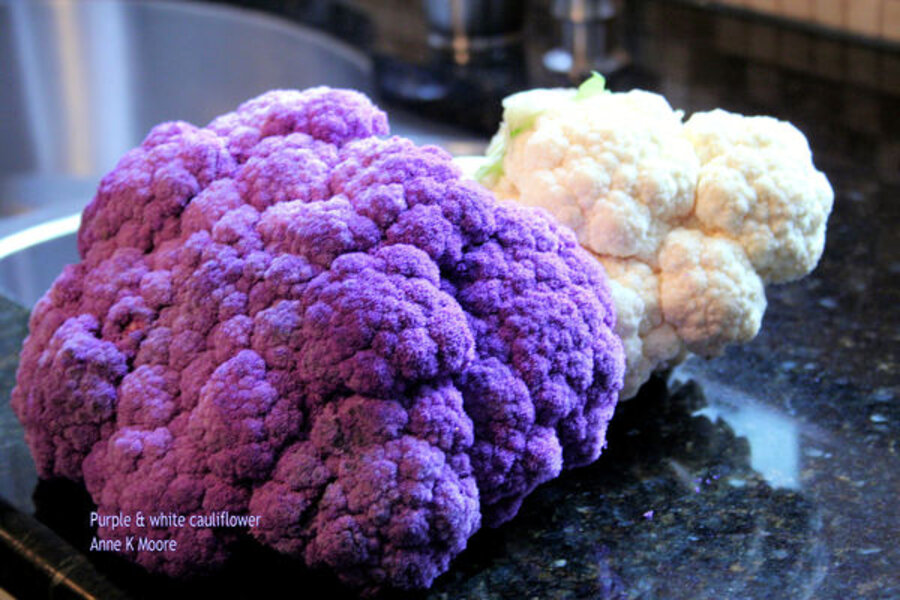Cauliflower in the garden and the kitchen
Loading...
When I (Anne Moore) was a new gardener, the only way to get a creamy white head of cauliflower was to wait until the outer leaves were long, and then tie them up over the developing heads. This blanches the curds so they stay white.
Nowadays, cauliflower not only grows leaves long enough to cover the head, but the leaves will arch over and start the blanching process all by themselves.
Cauliflower is one of those rewarding vegetables that grow with very little effort from the gardener. It develops best in the cool spring or fall months. Cauliflower plants should be available at garden centers from February to April. Since this spring has been on the extreme side of hot, you might want to postpone your cauliflower planting until fall if you live in the South. Cauliflower is a cool-season vegetable that dislikes heat and humidity.
Start from seed
Since finding fall vegetable plants can be nearly impossible, you can raise a fall crop of cauliflower by planting seeds in August indoors and raising your own transplants.
Put started plants outdoors in good garden soil, about a foot apart. Keep the soil moist. Wrap the stems of the plants, from below the leafy top to just under the soil surface, with strips of paper or aluminum foil to thwart cutworms.
To keep cauliflower on your table for several weeks, be sure to plant different varieties that will mature in different numbers of days. Some take only 55 days, while others can take up to 80.
Go beyond boring white
Romanesco is a funky-looking hybrid that resembles stacked seashells. It is pretty enough to use as a centerpiece and looks good “green” so it needs no blanching. Rambunctious little boys might be willing to try the white curds of “normal” cauliflower if you call them brains. Girlie girls might prefer their cauliflower in deep purple, which turns pale lavender when cooked. There is also a deep yellow-gold form called Cheddar.
Linda’s recipe, next, requires no coaxing to try this delicious treat.
Roasted Cauliflower Casserole With a Mexican Cheese Twist
Roasting the cauliflower for this casserole brings out the natural sugar and gives the vegetable a sweet crunchy texture, says Linda Weiss, the chef. Then adding more textures and seasonings has taken a mild vegetable to another level. I cut the fat content by using fat free half-and-half for the sauce, and reduced-fat cheese. I think you will like this one.
First, prepare the cauliflower:
1 tablespoon olive oil
1 large head cauliflower, cored and cut from the whole cauliflower top, into 1/2-inch slices (about 6 cups roasted)
Lawry’s seasoning salt
1 cup shredded, reduced-fat 4-cheese Mexican (I used Sargento’s for testing purposes.)
Preheat the oven to 400 degrees F. Line a large baking sheet with foil. Lay the cauliflower on the baking sheet and brush each side with olive oil. Sprinkle liberally with Lawry’s seasoning salt. Roast cauliflower for about 25 minutes or until caramelized and very tender. When cauliflower is done, break it apart, and place it in a 9-by-13-inch or 10-by-12-inch casserole dish that has been sprayed with a nonstick cooking spray. Add the cheese and mix with the cauliflower.
Then, prepare remaining ingredients:
2 tablespoon butter
2 tablespoons flour
2-1/2 cups fat-free half and half (I used Land of Lakes for testing purposes.)
1/2 teaspoon Worcestershire sauce
Pinch dry mustard
1 cup shredded, reduced-fat 4-cheese Mexican
3/4 cup crushed Ritz crackers
1 large tomato, thinly sliced
Lawry’s seasoning salt
3 slices bacon, cooked and crumbled
Add butter to a large skillet. When butter starts to sizzle, add the flour and stir for about 2 minutes, not letting the flour brown. Add the half and half, Worcestershire sauce, and dry mustard, and cook until mixture starts to thicken. Pour over the cauliflower-cheese mixture. Spread remaining cup of cheese on the top of the casserole. Add crushed crackers evenly over the cheese, then top with sliced tomatoes and sprinkle withseasoning salt. Bake in a 400 degree F oven for 25 to 30 minutes, or until casserole is bubbly and hot in the center. Add crumbled bacon to the top before serving. Serves 8.
Editor's Note: To read more of Anne and Linda's "how to grow and prepare" series, click here.
-----
Linda Weiss is a personal chef. She attended Le Cordon Bleu of Paris’ catering program and is a professional member of The James Beard Foundation and the Southern Foodways Alliance. Her cookbook, "Memories From Home, Cooking with Family and Friends" is available at Amazon.
Anne Moore is an award winning free lance writer. She is the horticulture editor, gardening consultant, and e-newsletter editor for GardenSmart.tv. She is a member of the Garden Writers Association. Follow Linda and Anne as they blog at www.thegardenerandthechef.com





